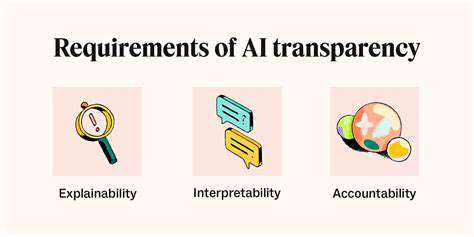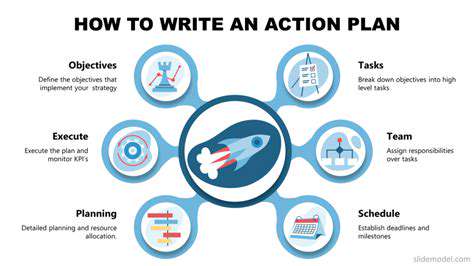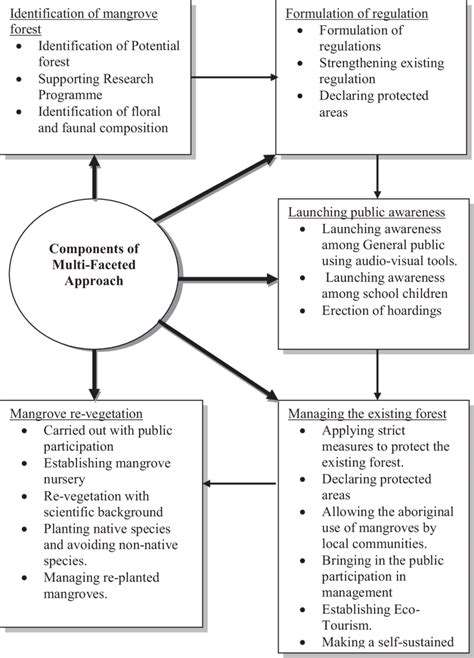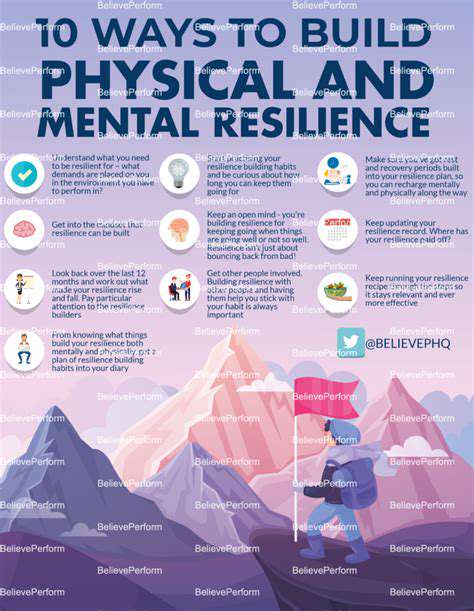Ethical AI in Mental Health: Safeguarding Privacy and Trust
Ethical Considerations in AI-Powered Mental Health Tools
The integration of artificial intelligence (AI) into mental health care presents significant ethical challenges that demand careful navigation. Transparency remains the cornerstone of ethical AI implementation, as patients and clinicians alike struggle to comprehend how algorithms reach conclusions affecting mental well-being. Without clear explanations of decision-making processes, trust in these technologies may erode before they achieve widespread adoption.
Beyond transparency, data protection emerges as a critical concern. These systems process enormous quantities of sensitive patient information daily, creating potential vulnerabilities. Implementing military-grade encryption and multi-factor authentication represents just the beginning of comprehensive security strategies needed to safeguard confidential health records from increasingly sophisticated cyber threats.
Bias and Fairness in AI Algorithms
Machine learning models inevitably inherit biases present in their training data, potentially reinforcing systemic inequities in mental health diagnosis and treatment. This algorithmic bias manifests most dangerously in marginalized communities, where historical underrepresentation in medical research creates distorted patterns in the data. Regular bias audits conducted by independent third parties could help identify and correct these dangerous distortions before they impact patient care.
The consequences of biased algorithms extend far beyond diagnostic inaccuracies. Treatment recommendations, resource allocation, and even insurance coverage decisions based on flawed AI assessments could perpetuate healthcare disparities across generations. Only through rigorous, ongoing evaluation of algorithmic outputs across diverse demographic groups can we hope to achieve equitable mental healthcare delivery.
The Role of Human Oversight and Collaboration
Despite technological advancements, the human element remains irreplaceable in mental health treatment. AI serves best as a clinical decision support tool rather than an autonomous practitioner. Mental health professionals require specialized training programs to effectively integrate these tools while maintaining appropriate skepticism about their limitations and potential errors.
The most promising applications combine AI's pattern recognition capabilities with clinicians' emotional intelligence and contextual understanding. This hybrid approach allows for treatment plans that consider both quantitative data and qualitative human experiences - a balance particularly crucial in mental health where subjective experiences often outweigh objective measures.
Accessibility and Inclusivity in AI Mental Health
Truly revolutionary mental health tools must overcome barriers of language, culture, and socioeconomic status. Current solutions frequently fail non-English speakers and individuals from non-Western cultural backgrounds due to narrow development perspectives. Multilingual interfaces and culturally adapted therapeutic content represent essential features for global mental health applications.
Economic accessibility presents another major hurdle. While tech companies develop cutting-edge solutions, cost barriers often prevent their adoption in public health systems serving the most vulnerable populations. Creative funding models and public-private partnerships may help bridge this gap, ensuring life-changing tools reach those who need them most.
The Impact on Mental Health Professionals
The mental health workforce faces unprecedented transformation as AI tools become ubiquitous. Clinicians must develop new competencies in data interpretation and technology integration while preserving essential human-centered skills. Professional certification programs should evolve to include mandatory AI literacy components, preparing practitioners for this blended future of mental healthcare.
Paradoxically, as AI handles routine assessments and monitoring, mental health professionals may find more time for complex cases and therapeutic relationships. This potential shift could help address chronic workforce shortages by allowing clinicians to focus their expertise where it's most needed.
Data Security and Privacy Concerns
In an era of frequent data breaches, protecting mental health information requires security measures exceeding standard medical data protocols. Differential privacy techniques and federated learning approaches allow analysis without direct access to raw data, potentially revolutionizing privacy protections. Regular penetration testing and blockchain-based audit trails could further enhance security for these highly sensitive records.
Transparent data governance policies must accompany technical safeguards. Patients deserve clear, jargon-free explanations about what data gets collected, how it's used, and who can access it. Interactive consent processes that allow granular control over data sharing could help rebuild trust in digital mental health solutions.


Modern vehicles rely heavily on fuel injection systems, which have largely replaced outdated carburetors due to their superior efficiency and emissions control. These systems meticulously regulate fuel delivery to the engine, creating an optimized combustion process. This precision engineering results in enhanced performance, better fuel economy, and reduced environmental impact - three critical factors in today's automotive landscape. Mechanics and car enthusiasts alike benefit from understanding these systems to maintain peak engine performance.
Promoting Transparency and Explainability in AI Systems

Promoting Openness in Decision-Making
Transparency in decision-making processes forms the foundation of ethical AI systems. The black box nature of many algorithms creates understandable anxiety among users and clinicians. Implementing explainable AI techniques like LIME or SHAP can demystify algorithmic decisions, showing which factors most influenced specific recommendations or diagnoses.
Beyond technical explanations, institutions must create accessible documentation describing system capabilities, limitations, and intended uses. This documentation should evolve alongside the technology, with version-controlled updates available to all stakeholders. Such transparency not only builds trust but also facilitates more effective human-AI collaboration in clinical settings.
Understanding Stakeholder Perspectives
Effective AI implementation requires ongoing dialogue with diverse stakeholder groups. Patients, clinicians, ethicists, and policymakers each bring unique concerns that must inform system design. Community advisory boards representing various demographics can provide crucial feedback during development and deployment phases.
Particular attention must focus on including representatives from historically marginalized populations. Their insights prove invaluable for identifying potential biases and cultural insensitivities that might otherwise go unnoticed by development teams lacking diverse perspectives.
Ensuring Accessible Information
Technical transparency means little if explanations remain incomprehensible to non-experts. Information about AI systems should be available in multiple formats - from detailed technical whitepapers to illustrated pamphlets and video explanations. Interactive decision trees could help users understand how their specific data inputs lead to particular outputs.
Accessibility extends beyond content format to delivery channels. Information should be available through healthcare portals, community centers, and mobile platforms to reach users across different technological and literacy levels.
Establishing Clear Communication Channels
Effective transparency requires structured communication protocols. Designated AI transparency officers could serve as points of contact for questions about system operations. Regular transparency reports documenting system performance, updates, and incident responses help maintain accountability over time.
Real-time explanation features, available during clinical use of AI tools, allow immediate clarification of system outputs. These might include confidence intervals, alternative interpretations, or flags indicating when human review is recommended.
Utilizing Technology for Enhanced Transparency
Emerging technologies offer novel approaches to transparency challenges. Interactive model visualization tools allow users to explore how changing inputs affect outputs, creating intuitive understanding of system behavior. Blockchain-based audit trails provide tamper-proof records of system decisions and updates.
Augmented reality interfaces could someday overlay explanations directly onto clinical workflows, helping practitioners understand AI recommendations in context. Such innovations must prioritize usability to avoid overwhelming users with unnecessary complexity.
Evaluating and Adapting Transparency Practices
Transparency measures require continuous assessment through user feedback and outcome monitoring. Metrics like comprehension rates, trust levels, and appropriate reliance on AI outputs help gauge effectiveness. Regular audits should examine whether transparency efforts actually lead to better understanding and more ethical use of these systems.
Adaptation mechanisms must be built into system governance structures. As users become more sophisticated in their understanding of AI, transparency approaches should evolve accordingly, maintaining relevance and effectiveness over time.
Fostering Collaboration and Ethical Guidelines
Promoting Collaborative Environments
Fostering collaboration across disciplines represents the only viable path toward ethical AI in mental health. Traditional academic silos must give way to integrated teams combining clinical expertise, technical skills, and ethical oversight. Joint appointment positions bridging computer science and psychiatry departments could catalyze this interdisciplinary work, creating hybrid experts fluent in both domains.
Collaboration shouldn't end at development. Ongoing clinician feedback loops, patient advisory panels, and cross-institutional working groups ensure systems remain clinically relevant and patient-centered throughout their lifecycle. This continuous engagement helps surface real-world challenges that may not appear in controlled development environments.
Establishing Ethical Guidelines for AI Use
Comprehensive ethical frameworks must address both technical and human dimensions of AI implementation. Beyond standard data privacy provisions, guidelines should mandate regular algorithmic fairness assessments across protected demographic groups. Ethical review boards specializing in AI applications could provide pre-deployment evaluations, similar to existing institutional review processes for human subjects research.
Guidelines must clarify appropriate use cases and limitations. Not all mental health applications suit AI solutions equally - certain diagnostic categories or therapeutic approaches may require greater human involvement. Clear boundaries prevent over-reliance on technology in situations requiring human judgment and emotional connection.
Ensuring Patient Privacy and Data Security
Mental health data demands protection exceeding standard medical records. Homomorphic encryption techniques allowing computation on encrypted data could revolutionize privacy protections, enabling analysis without exposing raw information. Strict data minimization policies should limit collection to only what's absolutely necessary for each specific application.
Consent processes must evolve beyond legalistic checkboxes. Dynamic consent platforms allowing patients to adjust permissions over time, with clear explanations of implications, empower individuals to make informed choices about their data. Regular privacy check-ins could reinforce understanding as systems evolve.
Promoting Accountability and Ongoing Evaluation
Clear accountability structures must accompany AI deployment. Designated individuals should oversee system performance, with escalation paths for addressing concerns. Publicly accessible incident reporting systems create transparency around problems and resolutions, maintaining trust when issues inevitably arise.
Longitudinal outcome studies tracking AI-assisted versus traditional care pathways provide crucial evidence about real-world impacts. These should examine not just clinical outcomes but also patient satisfaction, clinician experiences, and unintended consequences across diverse populations.
Read more about Ethical AI in Mental Health: Safeguarding Privacy and Trust
Hot Recommendations
- AI Driven Personalized Sleep Training for Chronic Insomnia
- AI Driven Personalization for Sustainable Stress Management
- Your Personalized Guide to Overcoming Limiting Beliefs
- Understanding Gender Dysphoria and Mental Health Support
- The Power of Advocacy: Mental Health Initiatives Reshaping Society
- Building a Personalized Self Compassion Practice for Self Worth
- The Ethics of AI in Mental Wellness: What You Need to Know
- AI Driven Insights into Your Unique Stress Triggers for Personalized Management
- Beyond Awareness: Actionable Mental Health Initiatives for Lasting Impact
- Creating a Personalized Sleep Hygiene Plan for Shift Workers











